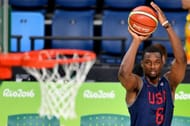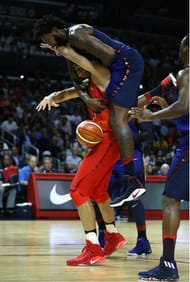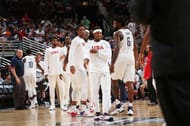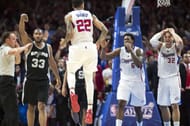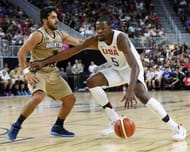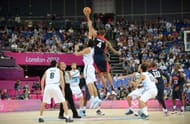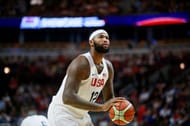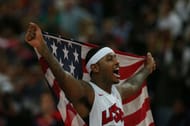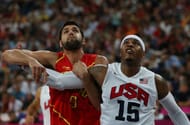The best basketball players from across the world are about to clash in the 2016 Rio Olympics. While the rules of the game are consistent for the most part, the NBA rules do differ from the FIBA international rules in a few aspects. Any one of these rules would have a significant impact on the outcome of a game, taken cumulatively they make for an entirely different game altogether requiring an overhaul in strategies.
The game has truly gone global, and the all-star teams routinely feature players from across the world. Back in 2012, the NBA featured a then record-tying 84 international players across the league.
The 2014 season saw a record 101 international players in the league from 37 different countries. Contrast that with the era of the Dream team, when we had just 23 international players at the start of the 1991-92 season. Competition has been catching up to the NBA, and some of these rules are in favor of competitive balance.
There has been a long-held belief that the international stage is quite different from the NBA owing to a different style of play. While that may be a unquantifiable metric, there are some concrete and quantifiable ways in which the international game is quite different from the NBA game.
Here are 10 ways in which the international FIBA rules differ from the NBA rules, and how the ramifications will play out:
#10 Shorter duration
The NBA matches are grind-out marathons lasting 48 minutes, plus five minutes per overtime period. Each quarter is 12 minutes long, and superstar players are accustomed to playing 30+ minutes per game in the NBA.
In international play, each quarter is shorter by 2 minutes, standing at 10 minutes per quarter. While being two minutes shorter seems negligible, it makes the entire match duration 40 minutes long. This has a huge impact on the game and substitution patterns.
For instance, in the 2008 Olympics, Kobe Bryant played 27 minutes in the final vs Spain. No player played over 30 minutes in that final from either team.
Ramifications:
For the most part, players willingly concede the minutes they are accustomed to play, and focus on the bottom line - winning. But there are times when it can rub a player the wrong way.
Serge Ibaka is one of the most enticing big men in the league for international play. His shooting range coupled with his proclivity for blocking shots makes him a great asset for Spain. But he decided to not participate in the 2016 Olympics, even though Marc Gasol is out with a foot injury.
Back in 2012, Ibaka had expressed discontent at his perceived lack of playing time, even though he was third in minutes played. NBA stars are used to a certain pecking order, and it can be an adjustment to concede minutes in the reduced playing time.
#9 Shorter 3-point line
The 3-pointer is a potent weapon in basketball. It serves as a strong equalizer and it can swing the momentum of a game in a matter of seconds. The 3-point line is shorter in international play, leading to mercurial momentum shifts.
USA coach Mike K has said, “The international game is not so much a paint game. It’s a lot of three-point shots.”
In the NBA, the 3-point line measures 23 feet and 9 inches at the top and 22 feet at the corners. In contrast, the 3-point line in international competitions ranges from 22 feet and 1.75 inches at the top of the arc and narrows to 21.8 feet and 8 inches at the corners.
Ramifications:
The conventional opinion would have it that international teams look to thrive from beyond the arc, but in the last two Olympic finals, USA has enjoyed a significant advantage from downtown. Check out the discrepancy in the USA's final games of the Olympics vs their opponents.
2012 Finals, USA 107-100 SpainUSA: 15-37Spain: 7-19USA win Finals by 7, 45-21 3-point-advantage
2008 Finals, USA 118- 107 SpainUSA: 13/28Spain: 8/17 USA win Finals by 11, 49-24 3-point-advantage
When they lost in 2004, they were outscored from 3-point-land.
2004- Semi Finals, Argentina 89-81 USAUSA: 3-11Argentina: 11-22USA lose Semis by 8, 9-33 3-point-disadvantage
Can it be that teams are more cautious with their attempts against USA? Or perhaps their perimeter defense discourages 3s. Whatever be the reason, it is clear that Team USA has fared well when it has taken advantage of the three-point line.
The phrase "Live and die by the three ball," has never held more sway than in international competition.
#8 Fouls
Basketball is not just about playing in the moment and giving every possession, everything you have. You have to exercise prudence and caution in different game situations. While players can be careful about accumulating personal fouls, the team as a whole has to bear the team foul situation in mind.
In the NBA, teams go into the penalty on the sixth foul. As in, if a team commits five fouls in a quarter, then the opponent will get two free throws on the next foul. However, in international play, the fourth foul puts a team in the penalty and the fifth foul in the quarter results in two free throws.
Another caveat in international play, the second foul in the last two minutes of a quarter will also put a team in the penalty. This offseason, the NBA adopted that rule as well. It used to be applicable only in the fourth quarter till recently.
In the NBA, two technical fouls result in a player being thrown out of the game. Same goes for international play, but here the technical fouls also count towards a player's foul total. So a player can be expelled with four personal fouls and one technical foul.
In the NBA, offensive fouls don't count towards team fouls. That's not the case in international play.
Ramifications:
“We’re constantly yelling out team fouls. That’s because the fifth foul is two free throws,” said coach Krzyzewski after the second exhibition win over China. “You can have guys out there not in foul trouble, but we’re in the bonus.”
Teams will need to keep an eye on the total fouls to avoid being in the penalty.
#7 Timeouts
The NBA allows for some fun moments when a player is on the floor desperately hanging on to the ball and trying to gesture for a timeout simultaneously while the opponents try to stomp him and/or mangle his limbs cheerfully. There have been cases when players calmly dribble the ball upcourt and fake calling a timeout, lull the opponents to sleep, and cruise in for a layup.
It’s different, man. It’s a little bit of getting used to and I think we’re doing a good job as a team and try to keep working. Harrison Barnes on playing with FIBA rules
The NBA offers teams six full timeouts to use in a game, along with a 20-second timeout for each half. If a game goes into overtime, teams have three more 60-second timeouts at their disposal. The 20-second timeout from the second half can carry over to overtime.
In international play, all timeouts are of a consistent length of one minute each. Teams have two timeouts available in the first half, and three in the second. In overtime, teams get just one extra timeout to use. Timeouts are not carried over in international play.
Ramifications:
International play eliminates that potential hilarity. Here, only the team coach can call a timeout. And he doesn't have to invade the court to do so either. The coach has to approach the scorer's table to call a timeout.
#6 Basket interference
In the NBA, the rules call for an imaginary cylinder above the basket. If a ball is above that cylinder, it can't be touched by either team. In international play, the moment the ball strikes the rim, players can make contact with it to swat it away or guide it in.
This particular rule difference is a boon to the players who love to play above the rim. Or who don't want to bet on their teammate's shot going in and need to nudge it anyway even if it results in basket interference as seen in the picture above. DeAndre Jordan, in particular, should have a field day with this rule on both ends of the court.
Ramifications:
Players won't have to leap at shots with trepidation. Look for them to attack shots the moment it hits the rim with impunity. This also eliminates the questionable calls where nobody is certain about whether the ball was on the imaginary cylinder or not.
#5 Defensive 3 seconds
In the NBA, in order to prevent teams from clogging the paint or over relying on zone defenses, the defensive 3 seconds rule was instituted. According to this rule, a defensive player cannot spend more than 3 seconds in the restricted area without actively guarding an opponent. There is no such restriction in international play.
France's Stifle Tower, Rudy Gobert, in particular, should love this rule change. He is perhaps the best interior defender in the Olympics along with DeAndre Jordan, and they both can now camp in the lane with impunity.
Ramifications:
This rule change will allow teams to park in the lane and discourage drives. It also enables them to play zone defense more freely. This results in teams resorting to three-pointers more often. Threes kill zones, and clogged paint invites threes as well.
#4 Alternating possessions on jump balls
Jump balls in-game situations always add to the unintentional hilarity in the NBA. If a point guard is grappling with a power forward for a loose ball, it is a foregone conclusion that the latter will win the jump ball. Awarding possession based on height and leaping ability might sound like it's keeping in with the basic premise of basketball, but that's not really the case.
The sport doesn't award one's height and vertical leap to the exclusion of all else, but the jump ball situations in-game during an NBA match does. In international play, teams are alternatively awarded possession on jump balls. The team which loses the opening tip gets the first possession in the event of a jump ball situation.
Ramifications:
There will be less of the confusion where a referee tries to throw the ball straight up and avoid getting hit. They’ll also duck having to explain why the ball wasn’t thrown straight up. Players often try to pin the opponent or jump up before the ball hits its peak. We won’t see any of that.
#3 5 seconds at free throw line
We've seen Dwight Howard contemplate the meaning of life at the free throw line and lose the free throw for taking longer than 10 seconds, which counts as a violation. What exactly does he ruminate on at the line is purely a matter of speculation, but it really ought not to take that long. One can always call a timeout if weighty matters burden the mind, but you don't need to stand at the free throw line and stare into nothingness for eternity.
One of the good things about the international play is that the game is expedited. Here, one gets just five seconds to release a free throw, otherwise, it counts as a violation.
Another caveat, if a teammate steps into the lane before a shot is made, the basket doesn't count in the NBA. But it will be counted in international play.
Ramifications:
The game will be faster and hopefully, free throw percentages can rise as players won’t have the time to think too much at the line.
#2 Floor Dimensions
Recently, Larry Bird opined that the league ought to play with the floor dimensions and add a 4-point shot. Keeping in mind the growing level of talent and freakish athleticism, executives have pondered expanding the floor in the NBA.
"Making the court bigger, it's an interesting idea and we've actually looked at it," said Kiki Vandeweghe, vice president of Basketball Operations at the NBA. It is worth noting that the court dimensions of the NBA court is already larger than the international standard.
In the NBA, the court measures 94 feet long and 50 feet wide. Whereas, in international play the court measures 91 feet and 10 inches long and 49 feet and 2.5 inches wide. The three point line is already shorter in international play, as discussed above.
Ramifications:
The smaller dimensions overall results in behemoths patrolling the lane and gazelles covering the end to end distance in a few bounds. This also makes for a more visceral experience in international play.
#1 Jersey number
Until 2014, FIBA only allowed players to choose from jersey numbers 4 to 15. Back in 1992, Magic Johnson made the strategic decision to choose number 15 so that his number would be the last one called during team introductions and he could waltz out at the end and appear as the big dog. Players will have a slightly more difficult time in planning such inventive strategies now that FIBA has allowed players to pick jersey numbers 01 to 99.
Gilbert Arenas would still be fuming at not being able to select the number 0 as it signifies the number of minutes he was told he'd play in the league by naysayers. It is also a play on his moniker "Agent Zero." Gilbert Arenas will not be making the USA team or any other international team for that matter, so that isn't a concern.
Ramifications:
Look for players coming up with creative back-stories behind their choice of numbers.
